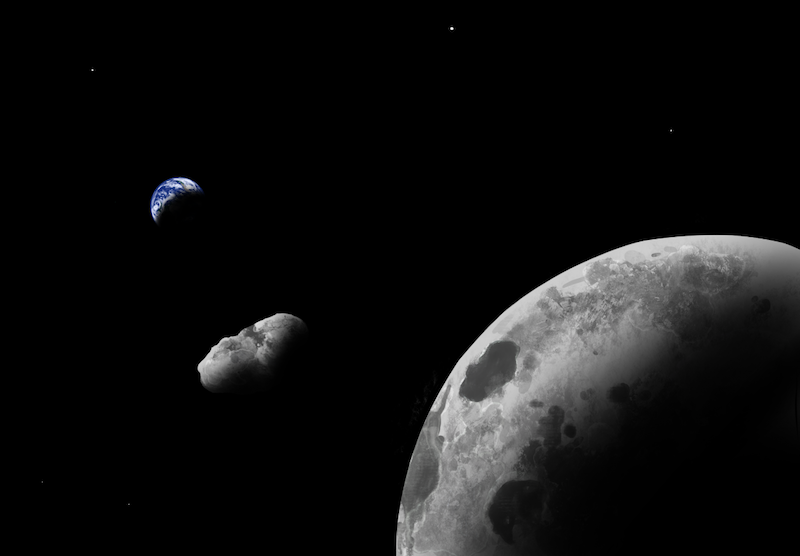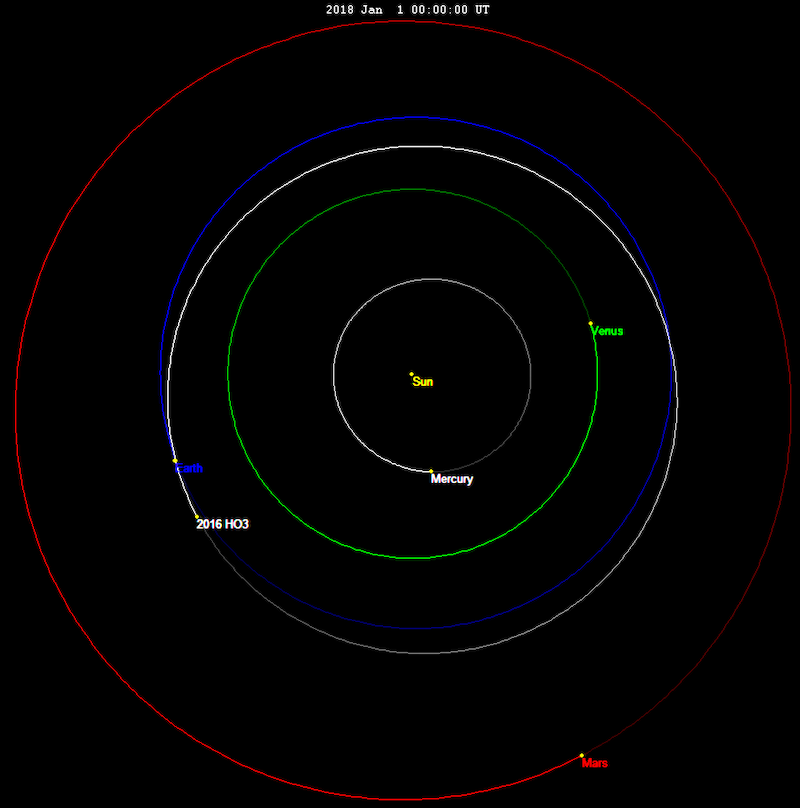
Did you know that Earth has a tiny quasi-satellite called Kamo’oalewa? It’s a near-Earth asteroid that remains fairly close to Earth in its orbit around the sun. Researchers from the University of Arizona announced on November 11, 2021, that this asteroid may actually be a long-lost piece of the moon.
That is the focus of a new peer-reviewed paper that Communications Earth and Environment (Nature) published on November 11, 2021.
An unusual near-Earth asteroid
Kamo’oalewa is a near-Earth asteroid, of which there are thousands. Notably, these are asteroids that could potentially pose an impact threat to Earth. They inhabit the inner solar system, and, therefore, are not part of the main asteroid belt between Mars and Jupiter.
This particular space rock is between 150 and 190 feet in diameter, about the size of an ordinary Ferris wheel, and gets as close as 9 million miles (14.5 million km) to Earth. It is still, however, difficult to detect. Indeed, as seen from Earth, it is very faint, about 4 million times dimmer than the faintest star that can be seen by the human eye.

A moon-like light spectrum
While Kamo’oalewa seems, for the most part, like any other near-Earth asteroid, the astronomers, nonetheless, found a surprise. Its pattern of reflected light, called a spectrum, was different than the other asteroids. In contrast, it didn’t look like the spectrum from any of the them. As Ben Sharkey, lead author of the study, noted:
I looked through every near-Earth asteroid spectrum we had access to, and nothing matched.
In fact, it looked a lot like the spectrum seen in rocks from the moon.

As explained in the paper:
This spectrum is indicative of a silicate-based composition, but with reddening beyond what is typically seen among asteroids in the inner solar system. We compare the spectrum to those of several material analogs and conclude that the best match is with lunar-like silicates. This interpretation implies extensive space weathering and raises the prospect that Kamo’oalewa could comprise lunar material.
In this case, the researchers discovered the unusual properties of the asteroid by using the University of Arizona-managed Large Binocular Telescope on Mount Graham in southern Arizona. Researchers also obtained some data with the Lowell Discovery Telescope in Flagstaff, Arizona. Co-author Al Conrad said:
These challenging observations were enabled by the immense light-gathering power of the twin 8.4-meter telescopes of the Large Binocular Telescope.
A lost piece of the moon?
Hence, for the past three years, the researchers have been searching for an explanation for Kamo’oalewa. Co-author Vishnu Reddy said:
We doubted ourselves to death.
As Sharkey added, the final result seemed to be, surprisingly, that the asteroid originated from the moon:
This spring, we got much needed follow-up observations and went, ‘Wow, it is real.’ It’s easier to explain with the moon than other ideas.
Also, Kamo’oalewa’s orbit is similar to Earth’s but slightly tilted. This, again, is different from other near-Earth asteroids. Coupled with the spectrum evidence, the tilted orbit also suggests that the asteroid originally came from the moon.

According to co-author Renu Malhotra:
It is very unlikely that a garden-variety near-Earth asteroid would spontaneously move into a quasi-satellite orbit like Kamo’oalewa’s. It will not remain in this particular orbit for very long, only about 300 years in the future, and we estimate that it arrived in this orbit about 500 years ago.
Kamo’oalewa is part of the Apollo group of asteroids. Scientists using the Pan-STARRS telescope at Haleakala Observatory in Hawaii discovered it on April 27, 2016. Its name, found in a Hawaiian creation chant, alludes to an offspring that travels on its own.
Bottom line: Astronomers at the University of Arizona say that a peculiar near-Earth asteroid may actually be a lost piece of the moon that broke off in the ancient past. If so, it would be the first known asteroid to have originated from Earth’s only natural satellite.
Source: Lunar-like silicate material forms the Earth quasi-satellite (469219) 2016 HO3 Kamo’oalewa
The post Piece of the moon? Asteroid may have lunar origin first appeared on EarthSky.
from EarthSky https://ift.tt/3nqHcfc

Did you know that Earth has a tiny quasi-satellite called Kamo’oalewa? It’s a near-Earth asteroid that remains fairly close to Earth in its orbit around the sun. Researchers from the University of Arizona announced on November 11, 2021, that this asteroid may actually be a long-lost piece of the moon.
That is the focus of a new peer-reviewed paper that Communications Earth and Environment (Nature) published on November 11, 2021.
An unusual near-Earth asteroid
Kamo’oalewa is a near-Earth asteroid, of which there are thousands. Notably, these are asteroids that could potentially pose an impact threat to Earth. They inhabit the inner solar system, and, therefore, are not part of the main asteroid belt between Mars and Jupiter.
This particular space rock is between 150 and 190 feet in diameter, about the size of an ordinary Ferris wheel, and gets as close as 9 million miles (14.5 million km) to Earth. It is still, however, difficult to detect. Indeed, as seen from Earth, it is very faint, about 4 million times dimmer than the faintest star that can be seen by the human eye.

A moon-like light spectrum
While Kamo’oalewa seems, for the most part, like any other near-Earth asteroid, the astronomers, nonetheless, found a surprise. Its pattern of reflected light, called a spectrum, was different than the other asteroids. In contrast, it didn’t look like the spectrum from any of the them. As Ben Sharkey, lead author of the study, noted:
I looked through every near-Earth asteroid spectrum we had access to, and nothing matched.
In fact, it looked a lot like the spectrum seen in rocks from the moon.

As explained in the paper:
This spectrum is indicative of a silicate-based composition, but with reddening beyond what is typically seen among asteroids in the inner solar system. We compare the spectrum to those of several material analogs and conclude that the best match is with lunar-like silicates. This interpretation implies extensive space weathering and raises the prospect that Kamo’oalewa could comprise lunar material.
In this case, the researchers discovered the unusual properties of the asteroid by using the University of Arizona-managed Large Binocular Telescope on Mount Graham in southern Arizona. Researchers also obtained some data with the Lowell Discovery Telescope in Flagstaff, Arizona. Co-author Al Conrad said:
These challenging observations were enabled by the immense light-gathering power of the twin 8.4-meter telescopes of the Large Binocular Telescope.
A lost piece of the moon?
Hence, for the past three years, the researchers have been searching for an explanation for Kamo’oalewa. Co-author Vishnu Reddy said:
We doubted ourselves to death.
As Sharkey added, the final result seemed to be, surprisingly, that the asteroid originated from the moon:
This spring, we got much needed follow-up observations and went, ‘Wow, it is real.’ It’s easier to explain with the moon than other ideas.
Also, Kamo’oalewa’s orbit is similar to Earth’s but slightly tilted. This, again, is different from other near-Earth asteroids. Coupled with the spectrum evidence, the tilted orbit also suggests that the asteroid originally came from the moon.

According to co-author Renu Malhotra:
It is very unlikely that a garden-variety near-Earth asteroid would spontaneously move into a quasi-satellite orbit like Kamo’oalewa’s. It will not remain in this particular orbit for very long, only about 300 years in the future, and we estimate that it arrived in this orbit about 500 years ago.
Kamo’oalewa is part of the Apollo group of asteroids. Scientists using the Pan-STARRS telescope at Haleakala Observatory in Hawaii discovered it on April 27, 2016. Its name, found in a Hawaiian creation chant, alludes to an offspring that travels on its own.
Bottom line: Astronomers at the University of Arizona say that a peculiar near-Earth asteroid may actually be a lost piece of the moon that broke off in the ancient past. If so, it would be the first known asteroid to have originated from Earth’s only natural satellite.
Source: Lunar-like silicate material forms the Earth quasi-satellite (469219) 2016 HO3 Kamo’oalewa
The post Piece of the moon? Asteroid may have lunar origin first appeared on EarthSky.
from EarthSky https://ift.tt/3nqHcfc

Aucun commentaire:
Enregistrer un commentaire